If you would like to find out more about how we can tailor our services to meet your needs, please contact us via the email address or telephone number below.
Find creative solutions to problems
Running an organisation, like life, presents many problems that need resolutions. We all have that “Eureka!” moment every so often when we have a great idea. But rather than wait it to happen by accident, consider this recipe to help enhance your creativity. See also our recipe on dealing with Strategy Block
Serves – most organisations
Preparation – the time taken to recognise that you have a problem which needs a solution
Cooking time – 7 days, sometimes less
Ingredients
- list of problems
- warm-up exercises
- notepad
- solutions
- 10 variations
- other problems
- break
- daily routine
- critical friend
Method
- Jot down a list of problems and pick one to focus on over the next 7 days, but keep this list to hand.
- Do some warm-up exercises to get you in a creative frame of mind. e.g. take the pen, brick, knife or other mundane object and jot down on the notepad as many uses for this object you can think of. Give your imagination free rein. Take the 4th sentence from page 25 of each of the books and create a story that tells the connection between the two. Don’t spend ages on these; it’s just a warmup exercise.
- For 15 minutes every day use a notepad to write a journal of whatever comes into your head.
- Think about the problem. On the notepad jot down any solutions that spring to mind, even if they appear ridiculous or risky at first sight. Don’t try to evaluate them yet! Keep the notepad by your bed while you sleep: a great idea may have been rumbling around in your unconscious mind for a while before you become aware of it. Waking up may bring it to the conscious mind. Part of a solution may even show up in a dream, so it’s important to jot down any thoughts you may have as soon as you wake.
- Consider whether you are asking the right question. Quickly, without over-thinking it, write 10 variations of the question. For example. if your problem is lack of funding for your group, instead of asking yourself “How to increase our funding?” you could ask “How can I get more people to support my group? Or “What do donors and funders want from us?” or “How can I make my group more attractive to funders?” One of your new questions will likely be a better one than your original and may head you toward a solution.
- Every so often remind yourself of the other problems of your list, because sometimes the best creative solutions come from fusing two problems together. For example, say the problem you are focusing on this week is “volunteers not feeling properly recognised or valued”, and another on your list is “lack of funding”. Maybe you could consider allowing volunteers to form a team to seek funding for a particular project, thus addressing two problems together.
- If your creative juices are not flowing, take a break. Relax or do physical exercise, go out for a walk or a run, meditate, play a game. These sorts of activities help your mind to wander and allow your subconscious to work, having the effect of freeing up your thinking.
- Consider changing your daily routine. Psychologists have found that doing mundane things a bit differently helps them approach problems with a fresh perspective. Apparently well-travelled neural pathways are abandoned, and new connections made between brain cells, and this can lead to new and original ideas. This is why people often have new ideas when they are in a different environment such as being on holiday.
- Once you come up with some good ideas – evaluate them. Talk to your mentor if you have one, they may have some insights. Compare one idea with another, looking at their pros and cons. Ask a trusted colleague to act as devil’s advocate or “critical friend”.




